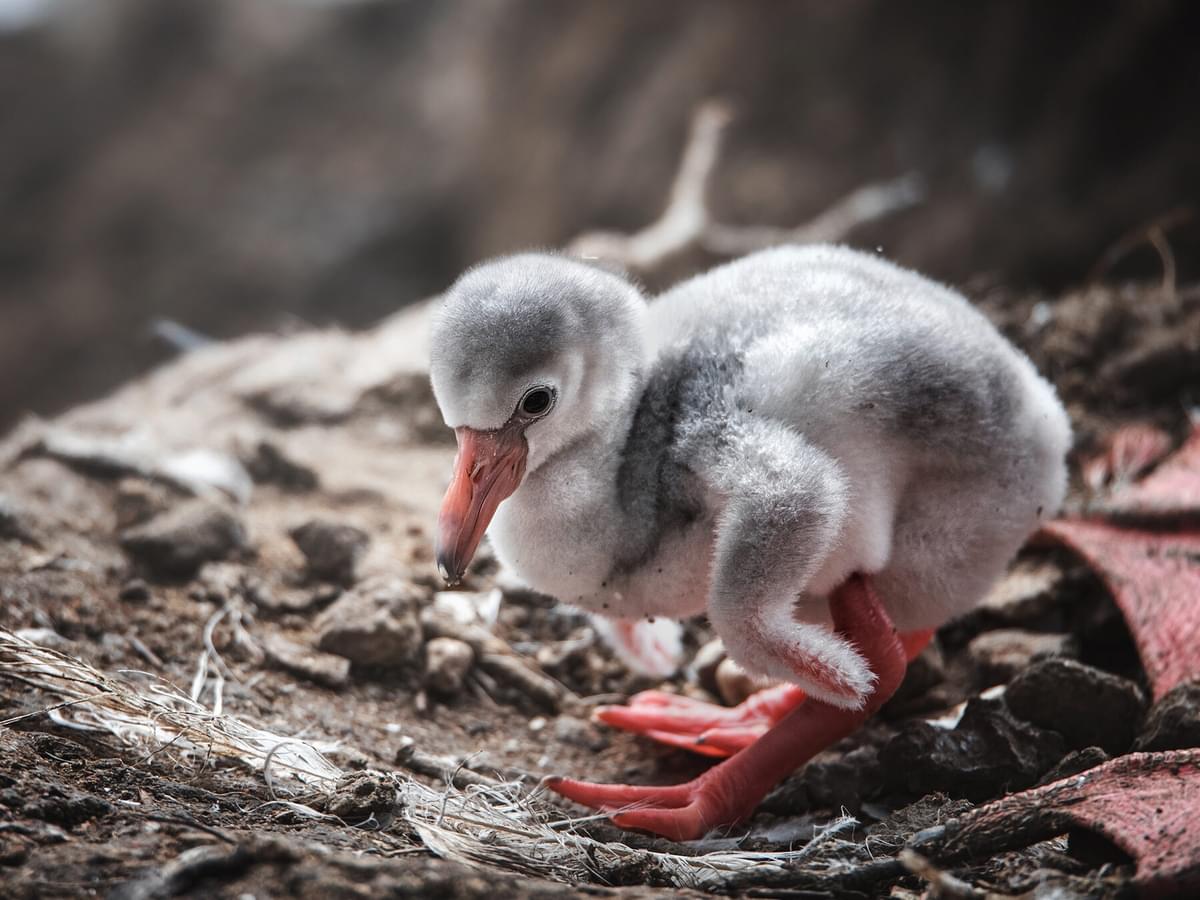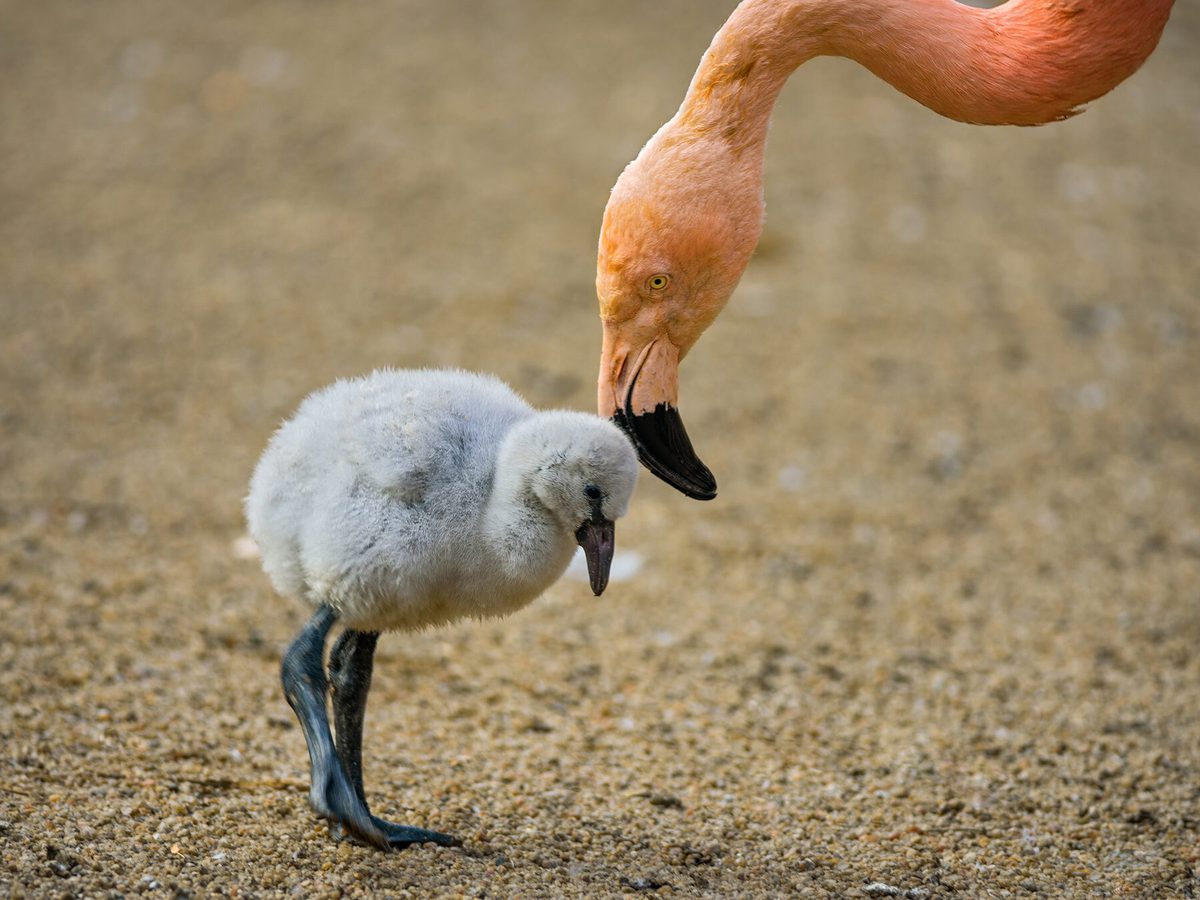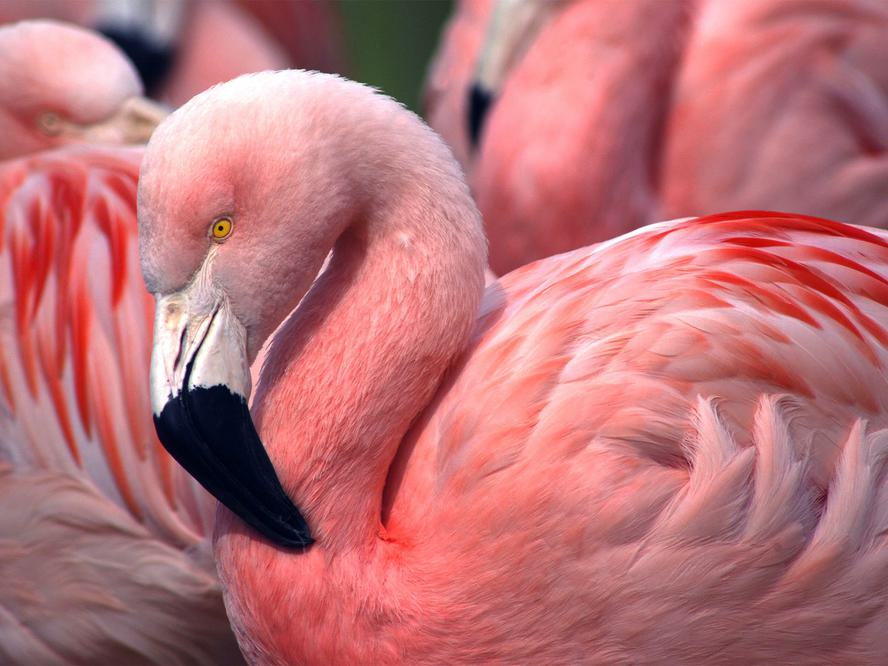Jump to Section
Baby Flamingos: Everything You Need To Know (with Pictures)
Last updated: 18 December 2023

Flamingos are a type of wading bird best known for their striking pink plumage, long slender legs, S-shaped necks, and their thick downward pointing bills. They are part of the family Phoenicopteridae. But what do we know about their babies? In this article, we have put together some of the most common questions asked about baby flamingos.
What does a baby flamingo look like?
The word flamingo comes from the Portuguese/Spanish word ‘flamengo’ meaning flame-coloured when translated and best describes the striking pink feathers of the adult flamingo.
However, newly-hatched flamingo chicks are not born as you would expect with the beautiful vibrant feathers found on their adult counterparts, but instead with grey or white coloured soft downy feathers. The fluffy down provides enough insulation to keep the chick nice and warm.
Newly hatched flamingos have short straight bills which are red/pink in colour. The bill lacks the distinct colour patches of the beaks of their elders. Their legs are thick and swollen and pink in colour. The swelling starts to decrease 48 hours after hatching.
Both the beak and legs turn black seven to ten days after hatching. At about 11 weeks of age, the bills of the young birds will gradually start to curve downwards.

Baby Flamingo with mother
How big is a baby flamingo?
Flamingo chicks are about the same size as a tennis ball (with legs) when newly hatched.
Female flamingos typically lay one large egg and rarely lay two. The egg is a chalky white colour, oblong in shape and slightly bigger than a large chicken egg. They range in size from 78mm x 49 mm / 90mm x 55mm long and weigh between 115 and 140 grams.
How much does a baby flamingo weigh?
It takes 27 to 31 days for the chick to hatch. The hatchling will weigh on average between 73 and 90 grams (2.5 - 3.2 ounces).
What does a juvenile flamingo look like?
The juvenile flamingo looks very different to its elders. Instead of having bright reddish-pink structured feathers, pink legs and a large distinguished beak as the adults, the young birds have fluffy grey coloured feathers, black legs and a greyish-white coloured beak.
The eye colour of the young birds is usually grey which differs from the adults too. Juvenile birds mature around the age of three to five years and usually get their pink feathers within the first couple of years from hatching.
Depending upon the species of flamingo, the primary and secondary feathers, wing coverts, leg, beak and eye colour vary too when the birds are fully mature.

Juvenile Flamingo
What is a baby flamingo called?
The term for newly hatched flamingos is a chick, chicklet or hatchling. However, it has been suggested by some people that ‘flaminglet’ is a much better way of describing them!
What do baby flamingos eat?
At first, flamingo chicks are fed ‘crop milk’ exclusively by both parents. Both parents produce crop milk in the lining of their upper digestive tract. The 'milk' is high in fat and protein and bright red in colour. Unlike mammalian milk, it is a semi-solid substance resembling pale yellow cottage cheese. Emperor Penguins, Woodpigeons and Doves are amongst some other birds that produce crop milk.
The chicks are able to feed themselves from around four to six weeks old but may still receive food from their parents until fledging at around 10 to 12 weeks old.
How do flamingos feed their babies?
Both parents regurgitate a type of liquid called 'crop milk' into the mouths of their newborns. They do this for four to six weeks or until such time that the chicks’ bill has developed enough for it to filter solid food.

Baby Flamingo being fed by parent
When can baby flamingos fly?
The young flamingos gain their flight feathers around 11 weeks from hatching. They generally start to fly when they are two to three months old. Young flamingos are not taught to fly by their parents but instead make numerous attempts at flying until they are successful.
How long are baby flamingos in the nest?
Baby flamingos will stay on the nest mound for five to 12 days after hatching.
They will leave the nest when they are strong enough and able to walk, usually after a period of four to seven days. The chick will explore its surroundings under the careful watch of its parents and will return to the nest to feed.
A flamingo’s nest resembles a mound of mud with a shallow hole in the top of it. It can be up to 30cm in height and take up to six weeks to complete. Feathers, sticks, stones and mud are some of the items used by the adult birds to construct the nest. Once the female has laid the egg, both parents will take turns to protect and keep it warm for between 27 and 31 days until it hatches into a chick.
How long do baby flamingos stay with their parents?
After about five days, the chicks will leave the nest and join small groups of other young flamingos and return to their parents to feed. The parent birds can identify the chick by its call due to vocalisation occurring hours before the chick hatches that establishes a bond between the parents and the chick.
Around three weeks from hatching, the adults herd the chicks into large groups called a crèche. The young birds are taken care of by a few adult birds and are fed only by their parents. The chicks will start to search for food on their own within the safety of the group. Baby flamingos fledge when they are 10 to 12 weeks old.

Baby American Flamingo
When do baby flamingos turn pink?
Young flamingos turn pink within a couple of years of being born. The colouration of an adult flamingo’s pink or reddish feathers, legs and face come from their diet of foods that are high in alpha and beta carotenoid pigments, including canthaxanthin. Algae and small invertebrates (insects, crustaceans and molluscs) make up most of their diet. The birds may lose some of their colouration and become paler if food sources are low.
When can flamingos reproduce?
Flamingos appear to be monogamous and start to mate at around six years of age. The birds engage in large courtship displays within their colonies to attract a partner. The courtship rituals are initiated mainly by male birds and include marching, preening and head-turning.
What colour is baby flamingo poo?
Flamingo poo is the same colour as other bird poo - greyish-white. However, the poo colour of very young flamingos may appear to be an orange colour due to them having lived off the yolk of the egg before hatching.
On this page
- What does a baby flamingo look like?
- How big is a baby flamingo?
- How much does a baby flamingo weigh?
- What does a juvenile flamingo look like?
- What is a baby flamingo called?
- What do baby flamingos eat?
- How do flamingos feed their babies?
- When can baby flamingos fly?
- How long are baby flamingos in the nest?
- How long do baby flamingos stay with their parents?
- When do baby flamingos turn pink?
- When can flamingos reproduce?
- What colour is baby flamingo poo?








